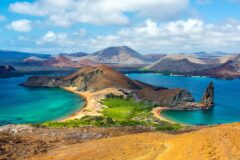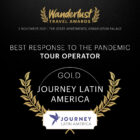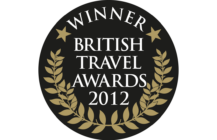
Overview & Highlights
Fly to the Antarctic Peninsula, avoiding the turbulent Drake Passage and enabling more time to be be spent around the Antarctic wildlife and natural wonders.
- Shore excursions on the Antarctic cruise
- Day trip to a vineyard near Santiago
Skip the often stomach-churning waves of the Drake Passage by flying from southern Patagonia for an Antarctic cruise, joining your expedition ship at King George Island, just north of the Antarctic Peninsula.
The Antarctic Peninsula is a slim finger of land and offshore islands reaching out from the main continental mass towards southern Argentina. In addition to prolific wildlife and extraordinary ice-carved landscapes, you will see evidence of the human impact – derelict whaling stations, and research outposts. This expedition provides an in-depth experience of the snow-capped mountains and icebergs of these more accessible fringes. The cliffs and bays are brought to life by the chattering and wheeling of birdlife, sea-lions and penguins.
By flying straight to and from the White Continent, you not only avoid the need to cross one of the most notoriously choppy stretches of water in the world, but also save 4 days of your holiday. Transiting through Chile therefore gives you the perfect opportunity to use these days (and maybe more) exploring some of this country’s many iconic regions, such as the hiking paradise of Patagonia, the desert moonscapes of the Atacama, the mysterious statues of Easter Island, or the relaxing hillsides of wine country. Simply let our team know your interests and we will find the right combination to suit you.
Please note: Many Antarctic expedition cruise operators offer early booking discounts and other restricted offers that depend on availability. Our advertised prices do not take these into account. Contact one of our Travel Experts for the best available rates.
Outline itinerary
Day 1
Arrive in Santiago. Transfer to your hotel in the smart residential district Providencia.
Day 2
Day trip to a winery.
Day 3
Fly to Punta Arenas
Day 4
Fly to the Antarctic and board your vessel
Days 5-8
Cruising the shores of the Antarctic Peninsula; land and sea excursions.
Day 9
Fly back to Punta Arenas for an overnight stay.
Day 10
Fly back to Santiago and overnight
Day 11
Fly home, or continue your adventure
Itinerary
Day 1
Arrive in Santiago. Transfer to your hotel in the smart residential district Providencia.
You will be met at the airport and escorted by one of our local representatives to your hotel in a modern district with shops, bars and restaurants nearby.

Day 2
Day trip to a winery.
Santa Rita is located at the foot of the Andes in the Maipo Valley, some 40 km from Santiago. It is one of Chile’s best-known vineyards, established in 1880 by Domingo Fernández Concha and has long gained a reputation among experts for the quality of its wines. Its cellars combine traditional French and American oak casks with modern processes, a combination that helps give a unique aroma and body to its wines. The estate also played a part in Chile’s battle for independence, when General O’Higgins and 120 of his soldiers sheltered here. Lunch is taken at a local restaurant, returning to Santiago in the late afternoon.

Day 3
Fly to Punta Arenas
Fly to Punta Arenas in Chilean Patagonia and transfer to your hotel. In the afternoon, you attend a briefing that provides important information about your voyage and reviews the essential guidelines for Antarctic visitors. Later there is a welcome dinner, a chance to get to know your fellow travellers.

Day 4
Fly to the Antarctic and board your vessel
Transfer to the airport for your 2-3 hr flight from Punta Arenas to King George Island on the South Shetland Islands, just north of the tip of the Antarctic Peninsula. Explore the area surrounding Chile’s Frei Station and Russia’s Bellingshausen station, before boarding a Zodiac to embark your expedition vessel.
We offer a choice of comfortable expedition ships for our air-cruises, including the sleek Magellan Explorer. All ships have ice-strengthened hulls and carry Zodiacs for exploration and remote landings. Each voyage is accompanied by a skilled team of expedition guides. Some are accompanied by a practicing scientist, historian, or researcher who conducts fieldwork during the trip.

Days 5-8
Cruising the shores of the Antarctic Peninsula; land and sea excursions.
Cruise between the South Shetland Islands and the western coast of the Antarctic Peninsula, sailing along ice-filled fjords and among gigantic icebergs, while enjoying the company of sea birds, penguins, seals and whales. Each day, disembark by Zodiac and explore the landscape together with expert polar guides. On board the ship, you may attend a programme of lectures and presentations, and enjoy superlative vistas, while sharing your daily adventures with fellow guests.
Wildlife you may encounter in the South Shetlands and the Antarctic Peninsula includes: gentoo, chinstrap and Adélie penguins; petrels; shags; elephant, Weddell and fur seals; and perhaps whales. You may also visit Deception Island, the centre of which is a volcanic caldera that last erupted in 1969, as well as other islands and bays. In Antarctica, silence is so complete that interruptions become indelible memories: noisy penguins squabbling over prized pebbles on Cuverville Island, the boom and crack of a calving glacier in Paradise Harbour, for example.
The soaring peaks and stark rocks of the Lemaire Channel are just the excuse you need to grab your camera gear for a shooting session from the deck, if the channel is free of ice. Exactly where the ship lands will vary from one expedition to the next and according to the weather an ice conditions as the ship edges its way southwards through the slush and abstract patterns formed by the sea ice.
Some departures offer optional excursions such as snow-shoeing and kayaking activities in addition to, or instead of, the traditional landings or Zodiac sailings. These activities are subject to additional cost. If you are interested in confirming a place on these activities, it is best to book with us before departing on your holiday as places may be limited.

Day 9
Fly back to Punta Arenas for an overnight stay.
Return to King George Island and disembark. Fly back to Punta Arenas for another overnight stay.

Day 10
Fly back to Santiago and overnight
Transfer to Punta Arenas airport and fly back to Santiago and overnight near the airport.

Day 11
Fly home, or continue your adventure
Either fly home, or continue your adventure by visiting some of Chile’s many fascinating and stunningly beautiful regions, or even hop to one of its neighbours for an entirely new experience.
Essentials
Tour info
Transport
4 flights (longest 4hrs); 6 day cruise.
Accommodation
The hotels in Santiago and Punta Arenas are good, practical mid-range options. There is a choice of comfortable expedition cruise ships, from mid-range to first class. Contact us for details.
Meals
Breakfast daily; Lunch on day 2; Dinner on day 3; Full board days 4-8.
Guides
We carefully select our local partners, some of whom we have worked with for over 25 years. Their English-speaking guides understand the expectations of our clients very well, and are consistently singled out for praise by the latter on their return.
Summary Of Nights
11 days, 10 nights: Santiago 2; Punta Arenas 1; Antarctic cruise 5; Punta Arenas 1; Santiago Airport 1.
Optional Excursions
These adventure activities are offered on selected departures:
- Kayaking (previous experience required).
- Snow-shoeing (no prior experience needed).
It is advisable to pre-book (and pre-pay) any optional activities, as many of these have limited numbers and can fill up before the cruise commences.
Currency
The local currency in Chile is the Chilean Peso. The ship works with US dollars and accepts credit cards.
How To Take It
Cash machines are available in all major Chilean cities and towns, and so taking a debit or credit card with a PIN number is the most convenient way of withdrawing money while on your trip, and in most shops and restaurants you can also pay by card. However, since cards can get lost, damaged, withheld or blocked, you should not rely exclusively on a card to access funds.
We recommend that additionally you take a reasonable quantity of US dollars cash (no more than is covered by your insurance), which you can exchange into local currency. Dollar bills should be in good condition, soiled or torn bills may be refused. You can take sterling, but the exchange rate is not always competitive or even available, restricting the number of places where you can change money.
On the cruise ship you can pay your bill for extras with a credit card (Most accepted excluding Diner’s Card), or in US dollars cash.
Daily Spend
Meals and drinks are included on board your expedition cruise. You pay for your extras (in US dollars or by credit card) at the end of the cruise. There isn’t much else to pay for on board.
In Chile, It is very difficult to give a guideline for essential expenses but a budget of around US$50 per person, per day should cover the cost of meals not included in the holiday itinerary, drinks and the odd souvenir. Eat at the best restaurants and you will pay considerably more.
Tipping
Tips are expected and local guides often rely on their tip as a significant proportion of their income.
Most service industry workers will expect a tip of some kind and so it is useful to have an allowance for cruise ship staff, hotel porters, taxi drivers and the like.
It is common to leave 10 – 12% in restaurants. On the cruise, a tip of $US 10 per person per day for the crew and guides is considered appropriate.
Tipping guidelines can be found in our Briefing Dossier.
Insurance
Travel insurance is essential. Make sure your insurance covers you for the full amount if you have to cancel.
Details of our recommended policy can be found on our Travel Insurance page.
Airport Taxes
If you have purchased your flights through Journey Latin America, the international departure tax is usually included in the ticket.
Trip Suitability
The flight to Antarctica:
The aircraft BAE-146 was manufactured in the UK by British Aerospace (which later became part of BAE Systems. It is operated by Aerovías DAP, which has more than 20 years of experience of flying in Patagonia and Antarctica.
The cruise:
Antarctica is very remote: once committed to your journey, you and your itinerary are at the mercy of the weather and ocean conditions, the melting and freezing of ice-packs, and the movement of icebergs. This is expeditionary cruising: you will be facing the same environmental challenges as the early explorers, albeit in much greater comfort, and with the assistance of modern technology and communications.
You must be in good health generally and you should be able to walk over slippery and rocky terrain. Although you spend as much time as possible ashore, you are welcome to remain aboard the ship if you like. To join most excursions, you must be able to get up and down a steep gangway from the ship to the water level to board the Zodiacs. Staff will assist you in and out of the boats. This will become progressively easier with practice.
There is a doctor on board but bear in mind that if you have a health issue while on the cruise or an accident it could be a long time and maybe an arduous journey before you return to a destination with good medical facilities, so bear this in mind if you have a pre-existing condition.
Climate
Santiago is hottest January-March with temperatures of 30°C but it should be dry.
Punta Arenas is best to visit in the summer (December-February) when days are long and mild. March and November can be sunny and clear, but it can be windy.
Antarctica is visited from late October to March, the southern hemisphere summer. Outside this period days are short and dark. The Peninsula has a typical maritime climate with average temperatures during the cruising season varying between 1°C and -15°C. Antarctica is a desert, so you won’t see much precipitation.
Clothing And Special Equipment
The southern hemisphere summer is hot in Santiago, so take loose-fitting light clothing for maximum comfort at this time. Spring and autumn are milder and less predictable.
South America is in general a relaxed continent and you won’t need clothes for formal dining but you may wish to take some smart casual wear for dining on the mainland.
On the cruise:
Protective clothing is the single most important way of ensuring a comfortable and enjoyable cruise and the key is to dress in layers. For Antarctic landings we recommend a breathable, thermal base layer to wick away perspiration; a warm mid-layer such as a fleece or down sweater and a wind and waterproof (but breathable) outer shell garment (some operators will provide an expedition jacket – please check your documents for details). Trousers should have a thermal lining (or wear a base layer of thermal leggings) and you will need waterproof trousers to wear over them. Plus of course warm socks, hat, scarf, gloves and sunglasses. Rubber boots are essential for Antarctic landings; these can be pre-ordered and are loaned on board free of charge. Dress on board ship is informal and it’s sensible to bring a spare change of warm, dry clothing for wearing out on deck between landings.
Please get in touch with the office before departure if you have any doubts. Good equipment is very important and hard to come by in South America.
Vaccinations
Preventative vaccinations are recommended against the following: typhoid; polio; tetanus; hepatitis A. You should consult your GP for specific requirements.
You can also find helpful information on the Masta Travel Health website.
Visas
Holders of a full British passport do not require a visa, although passports must be valid for at least 6 months after the trip begins. Anyone with a different nationality should enquire with us or check with the relevant consulate.
If flying to the US, or via the US you will need to fill in your online ESTA application.
Travelling Alone
Some cruise ships will accept individuals travelling alone who are willing to share a cabin with a person of the same sex, they will be charged the per person price based on two travelling together. If you prefer not to share a cabin, some ships will have dedicated single cabins, or you can opt to pay a single supplement to have a double/twin cabin to yourself. Expedition voyages tend to have a very sociable atmosphere on board and thus are very popular with solo travellers.
The Nature Of Antarctic Travel
Once on board, many factors play a role in shaping the expedition’s progress – the prevailing wind, weather and ice conditions, for example. Ideally, you will generally depart the ship by Zodiac to explore the peninsula with at least 2 excursions daily – on land, by zodiac or a combination of both, lasting anything between 2-4hrs. There are no man-made jetties in Antarctica so landfalls are ‘wet landings’ where you scramble ashore from the Zodiac in rubber boots and waterproofs. You are then free to explore on your own or in groups, before later being picked up again by Zodiac. Evenings may be spent relaxing, reliving the days’ events with a briefing or lecture, or out on the deck, keeping an eye on the dramatic, ever-changing scenery. Itineraries will vary from the original plan if conditions demand/permit.
It’s a long time at sea, but the variety and intrinsic fascination of what can be seen is spell-binding.
What To See And When
The theatre of wildlife in Antarctica as a whole displays an ever changing narrative of birth, struggle, pleasure, fulfilment and death. You may witness the comedy of a waddling penguin building its nest, a mother bird feeding its young or reuniting with a returning mate; a wily seal escaping the clutches of a hunting whale.
The large variety of marine birds that visit the White Continent, includes 6 species of penguin – Emperor, King, macaroni, chinstrap, gentoo and Adélie, but around the peninsula, you are likely only to see the latter 3. Mammals abound here: blue, orca, humpback, minke and southern right whales prowl the chilly ocean, while Weddell, Ross, crab-eater, leopard and elephant seals sprawl on the beaches.
Plant life in Antarctica proper is restricted to lichen, mosses and algae but there are hundreds of colourful varieties of these.
What to see as the season unfolds:
December – January:
- Long days of summer light, milder temperatures.
- Penguin chicks hatch in the Antarctic Peninsula.
- Whale sightings increase.
February – March :
- Excellent whale-watching opportunities.
- Penguin chicks begin to fledge.
- Fur seals increasingly numerous on the Antarctic Peninsula.
- Colourful snow algae break the snow white domination of the landscape.
- Spectacular sunrises and sunsets add a rosy glow to the ice.
Specific to your cruise:
South Shetland Islands and Antarctic Peninsula:
Visitors include chinstrap, gentoo, macaroni and Adélie penguins; giant petrels, Wilson’s and black-bellied storm petrels, brown and south polar skuas, Cape pigeons, Antarctic terns, blue-eyed shags, Dominican gulls, elephant, fur,
leopard and crab-eater seals; humpback, minke and orca (killer) whales offshore.
Antarctic Peninsula:
Chinstrap, gentoo and Adélie penguins abound. Breeding birds include skuas, Antarctic terns, giant petrels, snowy sheathbills, Antarctic shags, kelp gulls, Wilson’s storm, and Antarctic and snow petrels.
What's included in the price
- Services of our team of experts in our London office
- Services of Journey Latin America local representatives, local and cruise guides
- All land and domestic air transport; ocean cruise
- Accommodation as specified
- Meals as specified
- Excursions as specified, including entrance fees
Included Excursions
- Shore excursions on the Antarctic cruise
- Day trip to a vineyard near Santiago
What's not included in the price
- Tips and gratuities
- Meals other than specified
- International flights to Latin America
- Airport taxes, when not included in the ticket
- Optional excursions


































